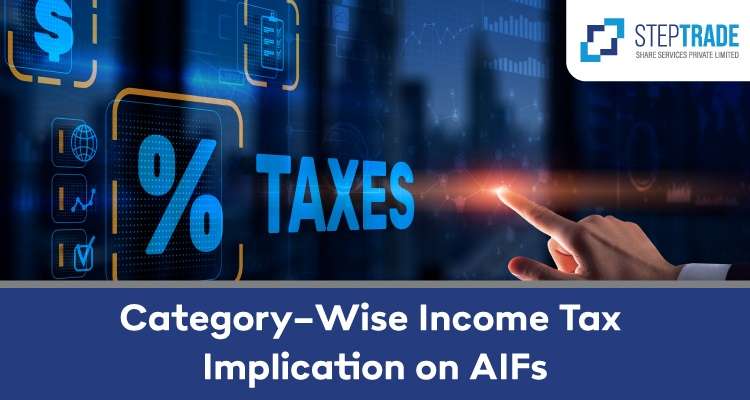The Alternative Investment Fund (AIF) is a great option for high-net-worth investors who want to diversify their investment portfolio. AIF can be in the form of a company, corporate body, trust, and limited liability partnership.
The income tax implication on AIFs is one of the crucial factors to understand when planning to invest in AIFs.
According to the SEBI Regulation, 2012, AIFs are divided into three categories: Category I, Category II, and Category III. Each of these categories is unique and tax differently.
Understanding tax implications properly before investing is crucial to make an informed decision.
In this blog, we will discuss the different categories of AIFs and the different taxation rules and implications of each category.
About AIF Category-Wise
Alternate Investment Funds (AIFs) are a type of investment vehicle that invests in a wide range of assets, including unlisted shares, debt, real estate, and private equity. AIFs are typically structured as trusts or companies and they are regulated by the Securities and Exchange Board of India (SEBI).
There are three categories of AIFs, each with its own tax implications:
- Category I AIFs: These AIFs invest primarily in venture capital and start-ups. They are given a pass-through status, which means that the income generated by the fund is taxed in the hands of the investor and not at the fund level.
- Category II AIFs: These AIFs invest in a variety of assets, including hedge funds, private equity, and real estate. They are also given a pass-through status, except for business income, which is taxed at the fund level.
- Category III AIFs: These AIFs are more speculative in nature and can invest in a wider range of assets. They are not given a pass-through status, which means that the income generated by the fund is taxed at the fund level.
Understand Tax Implications of Investing in Category I, II, and III AIFs in India
The tax implications for investors in AIFs depend on the category of AIF they invest in.
Investors in Category I and Category II AIFs:
- Capital Gains: Capital gains from investments in Category I and Category II AIFs are taxed in the hands of the investor at the applicable short-term capital gains (STCG) or long-term capital gains (LTCG) tax rates.
- Dividend Income: Dividend income from investments in Category I and Category II AIFs is not taxed in the hands of the investor.
Investors in Category III AIFs:
- Capital Gains: Capital gains from investments in Category III AIFs are taxed in the hands of the investor at the applicable STCG or LTCG tax rates.
- Dividend Income: Dividend income from investments in Category III AIFs is taxed in the hands of the investor at the applicable tax rates.
Additional tax implications
- Withholding Tax: AIFs are required to deduct withholding tax at the rate of 10% on all dividend income distributed to resident investors.
- Surcharge And Cess: Surcharge and cess are also levied on capital gains and dividend income from AIFs at the applicable rates.
Income Tax Implications of Investing in Category I, II, and III AIFs in India
Category I and II
| Type of Investment | Type of Investor and Income Tax Implication on AIF Category I and II |
|
Long-term capital gains (LTCG): |
|
| Listed shares | Whether it is an individual, HUF, LLP, Private Trust, or a Domestic company, the tax levied would be at the rate of 10%. |
| Unlisted shares | Whether it is an individual, HUF, LLP, Private Trust, or a Domestic company, the tax levied would be at the rate of 20% + indexation benefit. |
| Other assets | Whether it is an individual, HUF, LLP, Private Trust, or a Domestic company, the tax levied would be at the rate of 20% + indexation benefit. |
|
Short-term capital gains (STCG): |
|
| Listed shares | 15% |
| Unlisted shares and other assets | Individual: As Per Marginal Rate (MMR) |
| Dividend Income | Individual: As Per Marginal Rate (MMR) |
| Other Income | Individual: As Per Marginal Rate (MMR) |
Category III
Category III AIFs do not have a pass-through status, which means that the income generated by the fund is taxed at the fund level. This means that the investors will not have to pay capital gains tax on the profits earned from the fund.
However, the fund will have to pay tax on its income at the maximum marginal rate, which is 39% for the financial year 2023-24.
Ending Note
An alternative investment fund is one of the most profitable investment vehicles. However, the tax rule associated with can make it tough and complicated to understand for general investors.
If you are investing in CAT III of AIF funds, you don’t need to worry about it, as they are taxable at the fund level. On the contrary, with CAT I and CAT II, the investor has to bear the taxes; hence, being aware of the tax implications is necessary.
We hope this blog will help you gain a firm understanding of the taxation rules of AIF and you will invest in AIF more confidently.
If you are interested in investing in an Alternative Investment Fund and need expert guidance, look no further than Chanakya Fund Trust AIF.
We are a trusted financial service provider in India and experts in helping investors build lucrative investment portfolios.
Reach out to us today and allow us to create your AIF investment portfolio that drives higher returns.














